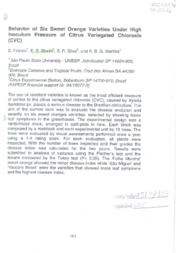Behavior of six sweet orange varieties under high inoculum pressure of citrus variegated chlorosis (CVC).
Behavior of six sweet orange varieties under high inoculum pressure of citrus variegated chlorosis (CVC).
Author(s): FRANCO, D.; STUCHI, E. S.; S. R. SILVA; MARTINS, A. B. G.
Summary: The use of resistant varieties is know as the most efficient measure of control to the citrus variegated chlorosis (CVC), caused by Xylella fastidiosa pv. pauca, a serious disease to the Brazilian citriculture. The aim of the current work was to evaluate the disease evaluation and severity on six sweet oranges varieties, selected by showing fewerleaf symptoms in the greenhouse. The experimental desing was a randomized block, arranged in split-plots in time. Each block was composed by a rootstock and each experimental unit by 18 trees. The trees were evaluated by visual assessments performed once a year using a 1-4 rating scale. For each evaluation, all plants were inspected. With the number of trees inspected and their grades the disease index was calculated for the two years. Results were submitted to analysis of variance using the Fischer's test and the means compared by the Tukey test (P< 0.05). The 'Folha Murcha'sweet orange showed the minor disease index while 'São Miguel' and 'Vaccaro Blood' were he varieties that showed more leaf symptoms and the highest disease index.
Publication year: 2007
Types of publication: Abstract in annals or event proceedings
Unit: Embrapa Cassava & Fruits
Keywords: Clorose, Fruta Cítrica
Observation
Some of Embrapa's publications are published as ePub files. To read them, use or download one of the following free software options to your computer or mobile device. Android: Google Play Books; IOS: iBooks; Windows and Linux: Calibre.
Access other publications
Access the Agricultural Research Database (BDPA) to consult Embrapa's full library collection and records.
Visit Embrapa Bookstore to purchase books and other publications sold by Embrapa.

